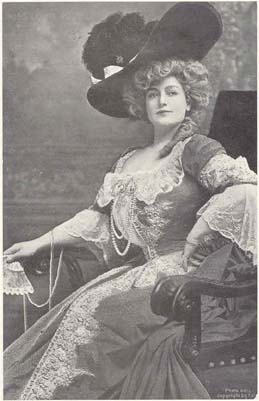COMÉDIA
MUSICAL
Na
segunda metade do século XIX, o Teatro clássico seguia seu
eterno curso de sucesso e glórias. Ocorria também o esplendor
do Teatro romântico. E acontecia uma transformação
importante: Uma valorização das formas teatrais mais intensamente
populares, as quais reuniam representações, pantomimas,
exibições diversas, músicas e danças, adquirindo
então características marcantes o Music-Hall inglês
e o Vaudeville francês. Esse refinamento dos espetáculos
de variedades foi assimilado e desenvolvido nos Estados Unidos e surgiu
então o American Vaudeville, uma das formas dominantes do Show
Business, no início do nosso século. Ali também estavam
em voga, bem como na Inglaterra, comédias ligeiras, operetas, formas
leves de entretenimento, muito apreciadas pelo público.
Tudo isso constituiu a
matriz de um genero onde a diversão banal já ganhava dimensões
mais sofisticadas e onde a arte popular atingia níveis mais altos:
a Comédia musical.
As atrizes que atuaram na Comédia musical, nos Estados Unidos e
na Inglaterra, alcançaram prestígio e popularidade realmente
notáveis, muitas se tornando célebres pela sua beleza e
pelo seu talento. Várias delas foram atraídas pelo cinema,
onde tiveram significativa participação.
Do painel onde estão
algumas das mais encantadoras estrelas da Comédia musical destacamos
Lillian Russell, durante muito tempo a mais popular e querida cantora
de seu pais, considerada a beleza típica americana, e que acumulou
sucessos, inesquecíveis canções e casamentos.
MUSICAL COMEDY
During
the second half of the XIXth. Century the classical theatre followed its
eternal course of success and glory. The splendour of the romantic theatre
was also taking place, and a very important transformation was occurring;
a greater value was beginning to be given to popular theatrical forms
that joined together acting, pantomime, variety shows, music and dance,
and gave to the English Music Hall and French Vaudeville some marked characteristics.
This refining of the variety shows was assimilated and incorporated in
the United States giving origin to the American Vaudeville, one of the
dominant forms of show business in the beginning of our century. The drawing
room comedies, operettas and light forms of entertainement that were so
much appreciated by the audiences and were the new fashion, were as popular
there as they were in England.
All of these facts became
the source of a genre where common entertainment gained more sophisticated
dimensions and where popular art reached higher levels: Musical Comedy.
The actresses that played in musical comedies in the United States and
in England, reached really remarkable reputation and popularity, and several
of them became famous for their beauty and their talent. Several of them
became attracted by the cinema where they came to hae a significant participation.
From this panel, where
we can find some of the most charming stars of Musical Comey, we have
seleted Lillian Russel who was for a long time the most popular and cherished
singer in the country, and considered to be a typical American beauty,
and who collected unforgettable hits, songs and marriages.
|
